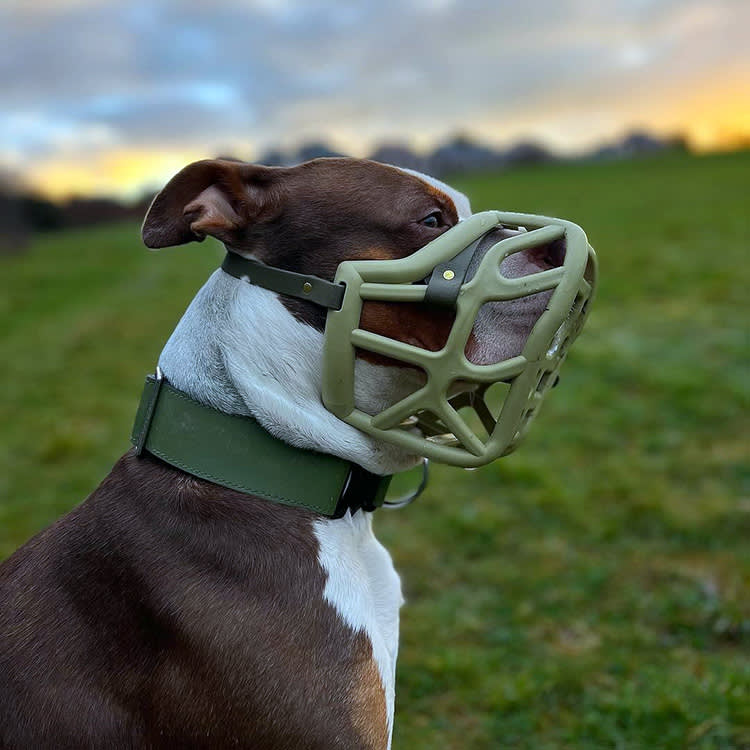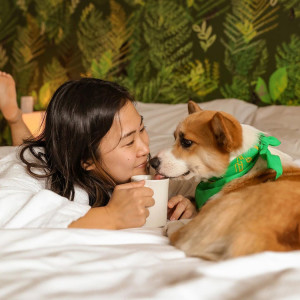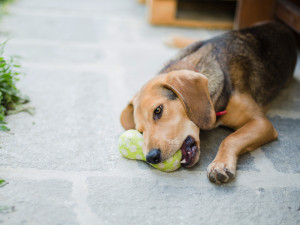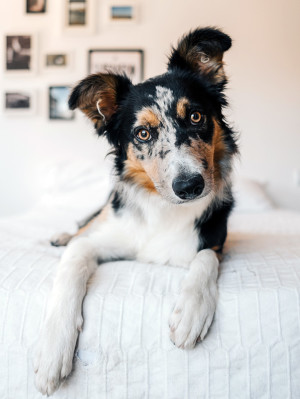How to Muzzle Train Your Dog
Contrary to common belief, muzzles aren’t solely for aggressive dogs

share article
As most pet parents would agree, ensuring the comfort and safety of our furry friends is paramount. Wearing a muzzle, often misconstrued to mean something negative, can hold an essential place in fostering a secure, comfortable and well-behaved environment for our beloved canine companions.
Whether for occasional use at the vet or as a behavioural aid, muzzles can be a key part of very happy and fulfilled dogs’ lives. We spoke to the experts on how to muzzle train your dog to ensure a positive and stress-free experience for both you and your four-legged friend.
Reasons for dogs to wear a muzzle
Contrary to common belief, muzzles aren’t solely for aggressive dogs. Following the recent addition of the XL Bully ‘type’ to the list of breeds under the Dangerous Dogs Act 1991opens in a new tab (the legislation that states any listed dog must be muzzled in any public place, including in cars) there will be an expected increase in pups wearing muzzles in public.
However, this doesn’t always mean that the dog is dangerous. The stigma attached to muzzle-wearing dogs can trigger fear in members of the public and other pup parents, when there are actually a multitude of reasons why wearing a muzzle, and muzzle training, can be beneficial to everyone involved.
“We should embrace muzzles in the first place, and stop looking at a dog wearing a muzzle as a dangerous dog, because we have the stigma attached,” says Adam Spiveyopens in a new tab, dog trainer and founder of Southend Dog Trainingopens in a new tab. “I see a responsible owner that is keeping people safe and keeping their dogs safe and putting in the time and effort. If more people used them, there’d be far fewer incidences regarding all breeds.”
In fact, the reason behind a dog wearing a muzzle could even be the complete opposite, explains Clara Hewsonopens in a new tab, founder and CEO of The Muzzle Movementopens in a new tab, a brand advocating for muzzle positivity through education, and their comfortable and playfully designed muzzles. “It may even be that the dog is super-friendly with people and dogs but can become mouthy if excited or frustrated,” she says.
Muzzles serve various purposes beyond controlling certain behaviours; they can prevent scavenging on walks, reduce barking or biting tendenciesopens in a new tab, aid in vet visits or grooming sessions, and safeguard against potential accidents in unfamiliar or crowded environments.
“Whilst a good proportion of dogs who need to wear muzzles may have used aggressive behaviouropens in a new tab towards people or other animals previously – so the muzzle is being used as a management tool to prevent bites, whether at all times in public, or in more specific situations such as veterinary or grooming settings – a muzzle could also be used to stop or reduce the dog from scavenging, to keep wildlife safe if the dog has high prey drive or maybe due to breed specific legislation or local laws,” says Clara.
Additionally, any animal can become a bite risk if they’re hurt or seriously unwell (even the most gentle of pups), so having that muzzle training to fall back on should the worst happen, means the muzzle won’t add any further stress to the pup. “Some people simply muzzle train their dogs in case of an emergency situation,” adds Clara. “For example, any dog is a significant bite risk if they get badly injured and need to be lifted into a car to be taken to a vet.”
What to look for in a muzzle
First of all, you need to choose the right style of muzzle depending on what it is being used for, says Clara. “For example, basket-style muzzles are not always effective if being used on a scavenger, and BioThane muzzles don’t generally offer bite protection. There are lots of different styles (plastic basket, metal basket, BioThane, vinyl and so on) – all with their pros and cons, so do your research,” she says.
The next most important part is ensuring the muzzle fits well. When wearing a muzzle, your dog should be able to:
open and close their mouth
eat
drink
take treats
pant comfortably
“The muzzle shouldn’t be more than 1–2cm longer than the dog’s nose as it could obstruct the dog’s vision or bump into their eyes as they sniff. Too short and it could rub their nose,” says Clara. The muzzle should be wide enough that it doesn’t rub or dig in the sides of the mouth but not too wide that it bumps around on their face.”
Clara started The Muzzle Movement in 2022 after adopting a Pointer, Tolly, who needed to be muzzled: “I knew from seven years working at the largest dog rescue in the UK [Dogs Trust] and previously trying to source muzzles for the dogs I’d worked with, that the market was lacking in comfortable, quality muzzles that offered suitable pant space.”
“I decided to change this by designing a brand new muzzle in a beautiful range of colours, which were comfortable for dogs,” adds Clara. Her small team – largely made up of people with a background in training and behaviour, in particular within the rescue industry – have designed a number of little extras in the brand’s muzzles, such as a specially designed treat hole at the front for easy food delivery when training, plus a range of mix-and-match colours to improve public perception of muzzled dogs.
How to measure for a muzzle
Before you even get to the muzzle training, let’s set you and your pup up for success (and make sure they’re looking super-snazzy) by making sure their new muzzle fits, and fits properly. Your dog should be able to eat, drink, take treats and pant comfortably in their muzzle. Not only will they be grateful that they’re comfortable, but it’ll also prevent any injuries or rubbing in the future.
Measure the length and depth of your dog’s muzzle to work out the right size (any excuse to get up close for a snuggle, right?), making sure to measure 1.5cm down from the eyes. Get over the first hurdle by making it a positive experience for your pup. “Introduce the tape measure beforehand, pair it with some tasty treats or try using a LickiMatopens in a new tab (if safe to do so and your dog has no resource guarding issuesopens in a new tab),” says Clara. “If possible, try to have someone film the measurements being taken so you can look back on it if needed.”
Most companies that sell muzzles will have measurement instructions on their websites, so check with the brand that you intend to buy from for more specific instructions. The Muzzle Movementopens in a new tab website has helpful videos and accompanying tips on the brand’s social media to help you get the current measurements.
How to muzzle train your dog
Most dogs don’t like surprises (unless it comes in the form of a delicious chicken treat), which is why training your pup to wear a muzzle is so important. Once you have the muzzle, start slowly introducing it to the dog’s environment to start to build a positive experience.
“The really important first stage is building a positive association with the muzzle – you want your dog to see the muzzle and be happy and excited to do some training, not avoidant and worried,” says Clara.
Start slowly. Like anything new, dogs are bound to be curious (or fearful, depending on your pup). Start by introducing the muzzle to your dog, and using a positive marker and reward when they sniff the muzzle.
“Use a food marker to mark the moment your dog does something that’s either making an effort towards or getting training right,” says Gayle Lucyopens in a new tab, a dog behaviourist, trainer and founder of K9 Coach UKopens in a new tab. “For example, if you hold the muzzle out for your dog to see, you can make the marker and give your dog some food. This will start to build a positive association and encourage the dog to come closer to the muzzle. You can build up to resting it on their face, and doing up and undoing the straps, marking your dog’s willingness and acceptance and giving pieces of food as you go.”
However, it's important not to rush things. Getting ahead of yourself and putting the muzzle on your furry friend before they’re ready could actually have an adverse effect, explains Clara.
“A key point of muzzle training successfully is ensuring that you are progressing at your dog’s pace and building up wearing the muzzle very slowly,” she says. “For example, we want to aim for our dog to simply sniff the muzzle in our hand to start with, then when they are comfortable doing that, progress to the dog’s nose just going into the opening of the muzzle, and only when they are completely happy with that, moving on to the dog’s nose going ¼ of the way into the muzzle and so on.”
Once your pup is comfortable wearing the muzzle for short bursts, start introducing wearing it for longer periods of time, and marking and rewarding through the muzzle so they associate wearing the muzzle with something positive (food, of course).
Remember that the key to muzzle training is that we want our pups to feel happy and comfortable when wearing a muzzle. “If your dog tries to paw it off or rub it off their face, or if they sit down and refuse to move, these are all big indicators that your dog is unhappy wearing a muzzle,” says Clara. Take a step back and start back at the beginning, and go slower, rewarding your pup at each step.
Training resources
If you’re more of a visual learner, there are several video resources available online from trainers as well as information available at The Muzzle Movement or on charity organisation websites:

Orla Pentelow
Orla Pentelow is a freelance journalist and copywriter based in London. When not at her desk she’s out and about with her rescue dog, Luna, who works primarily as chief distractor.
Related articles
![Grey XL Bully looking up at camera]() opens in a new tab
opens in a new tabHow to Protect Your XL Bully Under the New Ban
How to keep your dog happy and healthy under the new legislation
![Hiker and dog overlooking the top of a mountain]() opens in a new tab
opens in a new tab8 Ways to Be a More Eco-Friendly Pet Parent in 2024
Expert tips to help reduce your pet’s carbon pawprint.
![A woman laying on a bed with her dog with green palm wallpaper in the background.]() opens in a new tab
opens in a new tabSustainable Pet Parenting Can Be Stressful. Here’s How to Deal With it
“We have to be good to ourselves the way we want to be good to the planet”
![Dog laying on the ground guarding toy in mouth]() opens in a new tab
opens in a new tabHow to Get Your Dog to Stop Resource Guarding Their Stuff
If your dog growls when you get near their food or toys, read this right now
![woman in running gear petting a small dog in a park]() opens in a new tab
opens in a new tabWorkouts You Can Do With Your Dog – From Doga to Canicross
Walking is fun, but let’s kick things up a gear
![Portrait Of A Border Collie Dog.]() opens in a new tab
opens in a new tabIs Your Dog a Genius? A Study Says it’s Possible
If only there were a dog version of University Challenge








